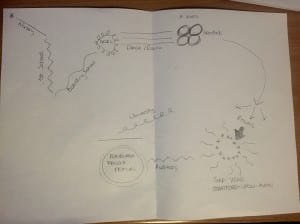This week was focused on the use of Thomas Lehman’s functions within a score. The beginning warm up allowed me to settle back in to improvisation despite having two weeks off and I actually found myself enjoying it. Working with Indre at the start, I found I was not thinking about the movement at all, I wasn’t using habitual movement and together we found interesting positions and combinations. This felt like a real step forward, I was not afraid to give the impulses and was keen to use other body parts, rather than just the hands or feet, such as my head, hip or knee. The only time I remember being afraid was when instructed to wrestle with one another as I didn’t want to just throw Indre to the floor and push her around.
When it came to the group ensemble, using Lehman’s functions of:
- Material
- Interpreter
- Manipulator
- Observer
- Mediator
I was aware of Lehman’s intentions, that Funktionen “demontrates and reflects the processes of communication on stage while it presents itself to the audience” (Husemann, 2005, 32), and so tried to maintain this idea. However, I found myself reluctant to enter the space, mostly because I didn’t fully understand the score, but also because I felt like by going in the space, I would ruin what was already being explored. Then when the piece ended I regretted my hesitations and wanted to try again. When watching the other half of the group, it was interesting to see how different their improvisation was to ours, they seemed to challenge each other a lot more, even fight over one another. With regards to the specific functions, I found it hard to interpret the material as I was worried that I would interpret it wrong, and you have to be more aware incase your material disappears and you have to switch to something else.
In the jam this week, we were given the chance to play with Lehman’s score again. This time I was determined to not be labelled as a “wing hogger” and so I entered the space as soon as I recognised the score needed something, for instance if there were several different materials and interpreters, I entered as the manipulator to throw them off guard and challenge them. The role I avoided the most was the observer, as I didn’t just want to stand in the space getting in the way.

I found it useful and interesting using the idea of Bill T. Jones in his production of Still/Here and encouraging the terminally-ill people to draw a map of their lives on paper and then show their journey within the space. I enjoyed the fact this provided us with our own material that we could explore and develop it however you wanted, it allowed me to explore the whole space more, rather than remaining in a certain space for a long period of time.
In terms of my actual movement, I discovered how my movement vocabulary has changed, I seemed to have lost the instinct to include my arms, and I focus more on my legs, fortunately I realised this half way through the jam and made it another intention to use my body as a whole unless working with specific body parts as a limitation. When interpreting the material, I again found this difficult and perhaps slightly intimidating, this time it was because it wasn’t just improvised movement I was interpreting, it was someones life story, which may contain delicate subject matter and so I was careful when interpreting.
With regards to timing, I still seem to be surprised with how quickly time passes when improvising. For instance in the jam session, I started on stage and didn’t exit the space for what I knew was a considerable amount of time, I just didn’t know exactly how long. And so when I did exit and the chime went off signalling 10 minutes left, I realised I had actually been improvising for 20-30 minutes! I’m not sure whether this is because I’m forgetting to track, or whether I’m doing the right thing and completely losing myself in the improvisation. I suppose unless I haven’t been asked to track time specifically, there is no need to, so I am allowed to just lose myself.
Overall, I began to enjoy this particular score and the idea of having actual roles in the space rather than just being there. I liked the prospect of perhaps engaging with the audience more by broadening the means of communication and in turn, widening their understanding. And next week I will continue to push myself by entering the space and not hesitating, trying to let the movement flow.
BillMoyers.com (2012) Bill T. Jones: Still/Here with Bill Moyers. [Online Video] Available from https://vimeo.com/33288787 [Accessed March 9 2015].
Husemann, P. (2005) The Functioning of Thomas Lehman’s Funktionen. Dance Theatre Journal. 21(1)31-35.